Related Research Articles

Lake Champlain is a natural freshwater lake in North America mainly within the borders of the United States but also across the Canada–U.S. border into the Canadian province of Quebec.
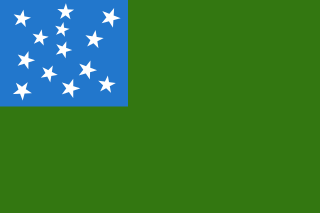
The Green Mountain Boys were a militia organization first established in 1770 in the territory between the British provinces of New York and New Hampshire, known as the New Hampshire Grants and later in 1777 as the Vermont Republic. Headed by Ethan Allen and members of his extended family, it was instrumental in resisting New York's attempts to control the territory, over which it had won de jure control in a territorial dispute with New Hampshire.
Fort Ticonderoga, formerly Fort Carillon, is a large 18th-century star fort built by the French at a narrows near the south end of Lake Champlain, in northern New York, in the United States. It was constructed by Canadian-born French military engineer Michel Chartier de Lotbinière, Marquis de Lotbinière between October 1755 and 1757, during the action in the "North American theater" of the Seven Years' War, often referred to in the US as the French and Indian War. The fort was of strategic importance during the 18th-century colonial conflicts between Great Britain and France, and again played an important role during the Revolutionary War.
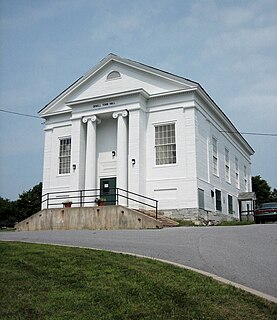
Orwell is a town in Addison County, Vermont, United States. The population was 1,239 at the 2020 census. Mount Independence was the largest fortification constructed by the American colonial forces. The 300-acre (1.2 km2) site is now one of Vermont's premier state-operated historic sites.

The Vermont Republic, officially known at the time as the State of Vermont, was an independent state in New England that existed from January 15, 1777, to March 4, 1791. The state was founded in January 1777, when delegates from 28 towns met and declared independence from the jurisdictions and land claims of the British colonies of Quebec, New Hampshire, and New York. The republic remained in existence for the next fourteen years, albeit without diplomatic recognition from any foreign power. On March 4, 1791, it was admitted into the United States as the State of Vermont, with the constitution and laws of the independent state continuing in effect after admission.

Fort Mifflin, originally called Fort Island Battery and also known as Mud Island Fort, was commissioned in 1771 and sits on Mud Island on the Delaware River below Philadelphia, Pennsylvania near Philadelphia International Airport. During the American Revolutionary War, the British Army bombarded and captured the fort as part of their conquest of Philadelphia in autumn 1777. In 1795 the fort was renamed for Thomas Mifflin, a Continental Army officer and the first post-independence Governor of Pennsylvania. The United States Army began to rebuild the fort in 1794 and continued to garrison and build on the site through the 19th century. It housed prisoners during the American Civil War. The army decommissioned Fort Mifflin for active duty infantry and artillery in 1962. However, while the older portion of the fort was returned to the City of Philadelphia, a portion of the fort's grounds are still actively used by the United States Army Corps of Engineers, making it the oldest fort in military use in the United States. Historic preservationists have restored the fort, which is now a National Historic Landmark.

Fort Crown Point was a British fort built by the combined efforts of both British and provincial troops in North America in 1759 at a narrows on Lake Champlain on what later became the border between New York and Vermont. Erected to secure the region against the French, the fort is in upstate New York near the town of Crown Point and was the largest earthen fortress built in the United States. The fort's ruins, a National Historic Landmark, are now administered as part of Crown Point State Historic Site.
Fort Independence is the name of several forts in the United States:

Fort Tejon in California is a former United States Army outpost which was intermittently active from June 24, 1854, until September 11, 1864. It is located in the Grapevine Canyon between the San Emigdio Mountains and Tehachapi Mountains. It is in the area of Tejon Pass along Interstate 5 in Kern County, California, the main route through the mountain ranges separating the Central Valley from the Los Angeles Basin and Southern California. The fort's location protected the San Joaquin Valley from the south and west.
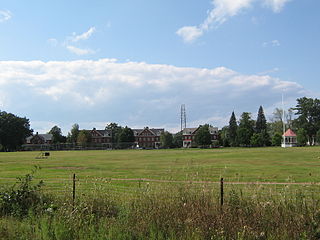
Fort Ethan Allen was a United States Army installation in Vermont, named for American Revolutionary War figure Ethan Allen. Established as a cavalry post in 1894 and closed in 1944, today it is the center of a designated national historic district straddling the town line between Colchester and Essex. Locally, it is known simply as "The Fort", and now houses a Vermont National Guard installation a variety of businesses, academic institutions, and residential areas.
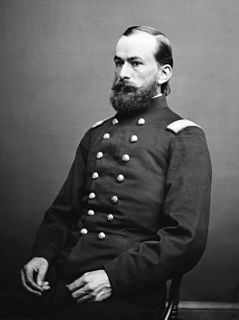
Asa Peabody Blunt was an officer in the Union Army during the American Civil War. He remained on active duty after the war. In recognition of his service during the Civil War, he was appointed to the grade of brevet brigadier general of volunteers. Blunt was notable as commander of the 2nd Vermont Brigade and the United States Disciplinary Barracks at Fort Leavenworth, Kansas.

The Old Constitution House is a historic house at 16 North Main Street in Windsor, Vermont. It is the birthplace of the Vermont Republic and the Constitution of the State of Vermont. A mid-18th century building built in a simple Georgian architectural style, the Old Constitution House was originally called the Windsor Tavern, and belonged to Elijah West at the time of the signing of the constitution. The house is a Vermont State Historic Site, and is administered by the Vermont Division for Historic Preservation. It is also listed on National Register of Historic Places, separately since March 11, 1971 as well as a part of the Windsor Village Historic District since April 23, 1975.

Mount Independence on Lake Champlain in Orwell, Vermont, was the site of extensive fortifications built during the American Revolutionary War by the American army to stop a British invasion. Construction began in July 1776, following the American defeat in Canada, and continued through the winter and spring of 1777. After the American retreat on July 5 and 6, 1777, British and Hessian troops occupied Mount Independence until November 1777.

The Whelk Point Fort was a colonial fort erected on the southeast part of Tortola in the British Virgin Islands. The fort fell into disrepair and ruin, and relatively little of the original structure remains. In 1992 a house was built over the original foundations of the fort, but the remains of the barracks can still be seen on the land behind the house. The ruins are on private property and are not generally accessible to the public.

The following is an alphabetical list of articles related to the U.S. state of Vermont.

The 12th Regiment Massachusetts Volunteer Infantry was an infantry regiment in the Union army during the American Civil War. It was formed on June 14, 1861, in Boston, Massachusetts. Its original commander was Colonel Fletcher Webster, son of the famed U.S. Senator from Massachusetts, Daniel Webster. The unit was known as the "Webster Regiment" after its first colonel.

The Rutland Jewish Center is a synagogue and religious community center at 96 Grove Street in Rutland, Vermont. It is located in the former H. H. Baxter Memorial Library building, a Richardsonian Romanesque structure that is listed on the National Register of Historic Places.

The Fort Vengeance Monument Site is an archaeological and commemorative site on United States Route 7 in northern Pittsford, Vermont. The site includes the archaeological remains of one of Vermont's oldest documented homesteads, and the only surviving site of a military fortification of the American Revolutionary War. The site is marked by a stone memorial placed in 1873, and was listed on the National Register of Historic Places in 2006.
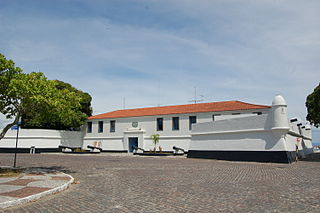
Forte de São Lourenço is a fort located in Itaparica, Bahia in Brazil. It sits on a strategic point at the north of Itaparica Island on a site used for whaling in the early 17th century. The Dutch constructed a small earthwork fortification on the site during the Dutch occupation of Brazil (1630–1654); it was reconstructed by the Portuguese in its present form in the early 18th century. The fort was used by Brazilian forces during the Brazilian struggle for independence in 1823; the Brazilian Navy has owned the fort since the same year. The Forte de São Lourenço was listed as a federal historic structure in 1938.